Abstract
Aims
To investigate dual-task interference between a concurrent cognitive task (auditory Stroop test) and obstacle avoidance in older adults with or without a history of falls.
Methods
Gait performance (temporal-distance parameters, range of motion and peak velocity of the center of mass) and verbal reaction time (VRT) in the secondary auditory Stroop task were monitored in 12 healthy young adults, 12 healthy older adults and 12 balance impaired older adults (BIOA) while they sat or walked with and without an obstacle in their path. VRT was used as an indicator of attention given to the secondary Stroop task.
Results
Under dual-task situations, all older participants reduced their gait velocity, taking longer strides and wider steps. BIOA significantly increased toe clearance of their trailing limb during obstacle avoidance. In all participants, cognitive attention to the Stoop task, as measured by VRT, was diminished as the level of difficulty in the activity increased; however, the effect was blunted in BIOA compared to healthy subjects.
Conclusions
Performing two tasks was highly inefficient among BIOA, as their performance in the gait and secondary task were both modified under dual-task situations. It is possible that dual-task interference in BIOA may be due to the inability to shift attention between the two tasks without primarily prioritizing gait. The findings suggest that BIOA should perform one task at a time in daily activities in order to reduce the risk of falling.
Keywords: Attention, aging, dual-task, falls, gait
INTRODUCTION
Previous research in balance-impaired participants has shown that the ability to recover stability after external perturbations is greatly decreased under dual-task conditions (1–2). An inability to recover from disturbances during gait may account for the majority of falls in balance-impaired older adults (BIOA) (3–4). Since many falls occur while simultaneously walking and performing a second task (such as engaging in conversation or carrying an object) (5–7), examining the attentional demands of secondary tasks on balance control in gait is a critical research area.
Studies have found that, compared to young adults, healthy older adults demonstrate a reduction in the ability to efficiently perform a gait and cognitive task simultaneously (8–9). BIOA either stopped (10) or required a longer time to complete a gait task with an additional secondary task (11). While recent research has begun to explore age-related changes in the ability of older adults to perform balance tasks, only a few studies were conducted to examine their ability to step over an obstacle under dual-task conditions (12–14). Those studies found that obstacle avoidance was degraded in older adults when their attention was distracted by a secondary task. However, those research findings were limited to healthy populations.
In fact, trips or slips during obstacle avoidance are one of the most common reasons for falls among older adults (15), no one has characterized the ability to maintain and recover stability during perturbed locomotion (for example, obstacle avoidance tasks) in older adults with balance impairments under dual-task conditions. The purposes of this study were to examine the attentional demands of postural control in young, older adults and elderly fallers during obstacle crossing and to better understand the dual-task interference in different postural tasks (seated, level walking and obstacle avoidance) in BIOA. It was hypothesized that attentional demands of postural control would be much greater in fallers than healthy adults during obstacle avoidance. It was predicted that a greater impact on gait performance would be found for BIOA, compared to young and healthy older adults, while performing a secondary task and obstacle avoidance simultaneously.
METHODS
Participants
Prior to testing, each participant signed informed consent approved by the University of Oregon Institutional Review Board. Twelve healthy young adults (HYA) (Age 22.8 ± 2.7), 12 healthy elderly adults (HOA) (Age 74.1 ± 5.0) and 12 BIOA (Age 81.0 ± 4.5) were recruited. Percentage of women in HOA and BIOA groups were 75 and 66.7%, respectively. All elderly participants had no history of neurological or musculoskeletal deficits that might contribute to instability and falls. All BIOA were greater than 65 years of age, lived independently in the community, had confirmed balance control complications on the Berg Balance Scale (score < 52, out of a total of 56) (16), and self-reported one or more falls in the previous 12 months.
Auditory Stroop test
The Stroop task itself consisted of the recorded words “high” or “low” spoken with a high or low pitch. Congruency between pitch and the word was randomized. The participant was to verbally respond the pitch of the voice as quickly and accurately as possible. Accuracy and reaction times were recorded during each trial. Verbal reaction times (VRT) during Stroop tasks were calculated from the time difference between Stroop stimulus onset and the onset of the verbal response. Differences in VRT between congruent and incongruent conditions were used to calculate the congruency effect. The auditory Stroop task was implemented by SuperLab Pro v.2 (Cedrus, San Pedro, CA), with stimuli relayed via two speakers.
Experimental apparatus
All data with 3D marker trajectories were collected by an eight-camera motion analysis system (Motion Analysis, Santa Rosa, CA) with a sampling rate of 60 Hz in the Motion Analysis Laboratory of the University of Oregon. Twenty-nine retro-reflective markers were placed bilaterally on bony landmarks of the body similar to previously validated marker setups (17). EVaRT 4.4 (MotionAnalysis, Santa Rosa, CA) was used to track the markers in space. Virtual markers were created at joint centers and combined with anthropometric data to determine the center of mass (COM) locations for each of thirteen body segments (18). The whole-body COM was then calculated from each segment COM with a weighted sum method (18). The velocity of the COM was estimated with the use of Woltring’s generalized cross-validated spline algorithm (19).
Stride length and stride time were determined from the position change of the heel marker. Average step width of two steps was calculated from the joint center between the ankles at heel strike. Gait velocity was calculated from the time and position change of the COM.
Ground reaction forces and moments were collected by two in series force plates (Advanced Mechanical Technologies Inc. Watertown, MA) with a sampling rate of 960 Hz. A lightweight PVC pipe crossbar was used as an obstacle set at 10% of the participant’s body height. For obstacle-crossing trials, the toe-obstacle clearances (TOC) for the trailing and leading limbs were determined from the vertical position of the toe marker. All elderly participants wore a safety harness to prevent injury from accidental falls.
Verbal responses to the Stroop task were recorded through a microphone (AKG Acoustics, Vienna, Austria). The four photocells (RadioShack, Fort Worth, TX) and walkway are shown in Figure 1. The first photocell served as the trigger for initiating the Stroop task program and the other three photocells were placed to randomly trigger a Stroop stimulus at heel strike before and after obstacle crossing and during swing phase of the gait cycle. Analog signals from force plates, the Stroop stimulus and microphone recordings were collected at 960Hz.
Figure 1.
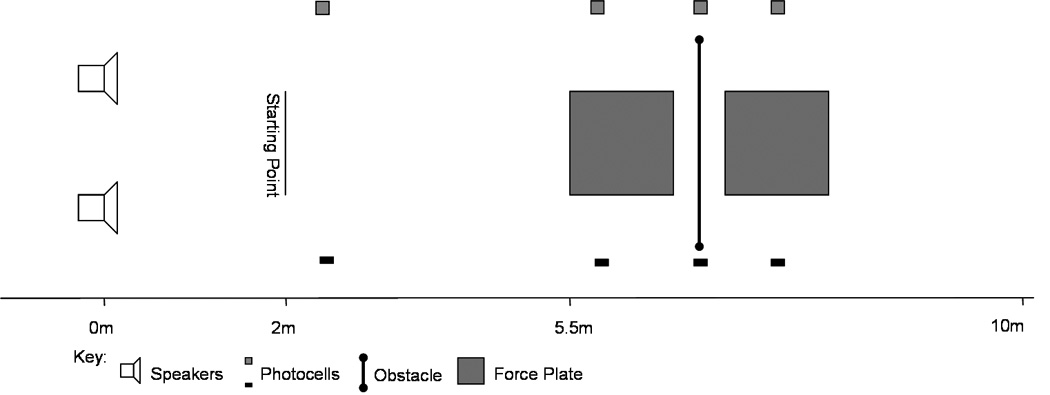
Experimental Setting
Experimental design
Testing began with eight seated Stroop trials. Motion data collection started with four single task trials (two for level-walking and two for obstacle-crossing conditions) at a comfortable self-selected pace. Dual-task conditions were then performed with the auditory Stroop test during either level walking or obstacle crossing. Location of the auditory stimulus presentation was randomized across trials, except during randomly dispersed catch trials (5%) with no stimulus. Vision was occluded prior to each trial so that the participant could not preprocess the information about the type of walking condition for that trial. Finally, another set of four single task trials (two for level walking and two for obstacle crossing conditions) and eight seated trials were performed. A total of 72 trials including level walking and obstacle crossing were completed for each participant.
Data Analysis
Statistical analyses were performed with SAS 9.0 (SAS Institute Inc., Cary, NC). A mixed model analysis of variance was used to compare the effects of postural condition, congruency of Stoop task, and single vs. dual task. Gait parameters and VRT were used as dependent measurements. A three-way ANOVA with three groups (HYA, HOA and BIOA), three postural conditions (seated, level walking and obstacle crossing) and two congruency conditions in the Stroop task (congruent and incongruent conditions) was used to test the significant differences for VRT performance. In addition, a three-way ANOVA with three groups (HYA, HOA and BIOA), two postural conditions (level walking and obstacle crossing) and three testing situations (single task, dual task with congruent Stroop and dual task with incongruent Stroop) was used to test the significant differences for gait parameters. A two-way ANOVA with three groups (HYA, HOA and BIOA) and two postural conditions (level walking and obstacle crossing) was used to test the significant differences for errors. Only trials with correct verbal responses were included for gait-related statistical analysis. All significance levels were set at p < 0.05.
RESULTS
Auditory Stroop task performance
No differences in VRT were found when comparing the three stimuli locations among all participants. Comparing the two postural conditions, more errors were found during the obstacle avoidance task (57 errors) than level walking (15 errors) for all trials. Within the obstacle avoidance task, more errors were found in HOA (22 errors) and BIOA (26 errors) than among HYA (9 errors) (p < 0.05).
In Figure 2, there was a significant group (p < 0.001), condition (p < 0.001) and congruency (p < 0.001) effect. There was no significant Group*Condition*Congruency interaction in the VRT performance. However, a significant Group*Condition interaction showed that VRT performance for each condition differed between three groups (F4, 66 = 6.73, p < 0.01). Only HOA and BIOA increased VRT significantly when the postural condition become more challenging.
Figure 2.
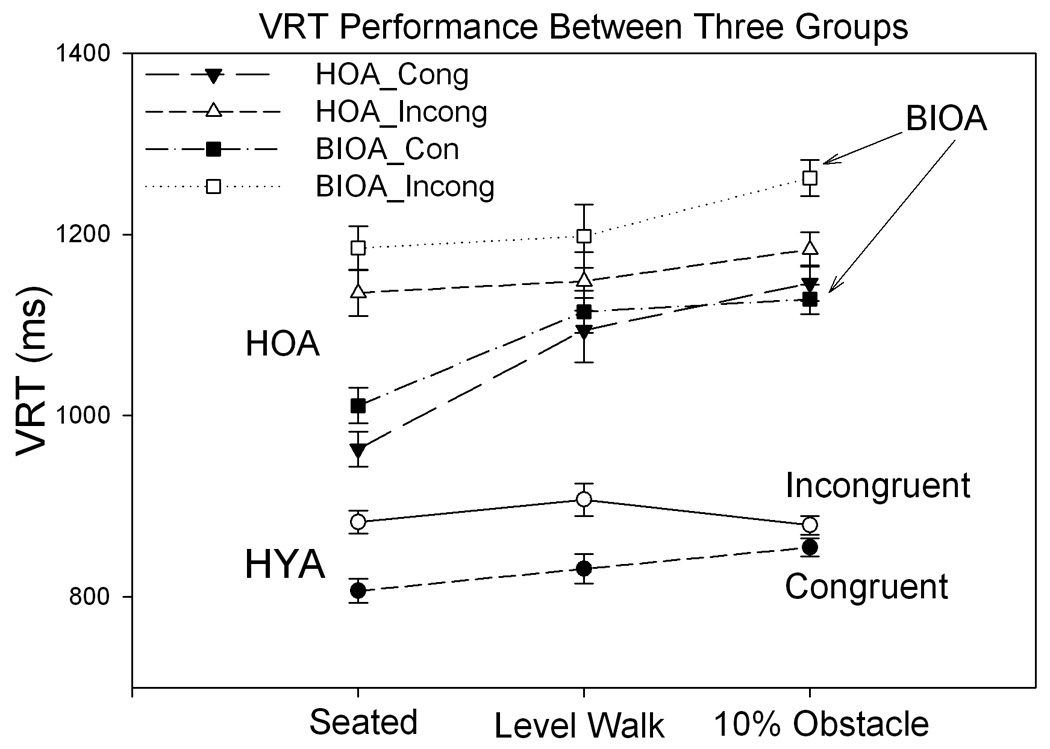
The average VRT performance (mean ± standard errors) among HYA, HOA and BIOA in three postural conditions. Solid symbols represent congruent situations and open symbols represent incongruent situations.
A significant Condition*Congruency interaction revealed that the congruency effect (difference in VRT between congruent and incongruent situations) varied across the three postural tasks (F2, 70 = 9.05, p < 0.01). The congruency effect was significantly larger in the seated condition compared with the two walking conditions among all participants. Specifically, a significant congruency effect was found in BIOA (p < 0.001) performing the obstacle avoidance trials. BIOA showed a larger congruency difference (134 ms) than in HYA (26 ms) and HOA (37 ms).
Gait performance
The main effects of group, condition and testing situations all are significant for both gait velocity and stride length (p < 0.01). Only significant group effects (p = 0.0006) and condition effects (p < 0.001) were found in stride time and only significant condition effects (p < 0.001) and testing situations effects (p = 0.0024) were revealed in step width. There was no significant three-way interaction (Group*Condition* Congruency) for all gait temporal-distance parameters (Figure 3).
Figure 3.
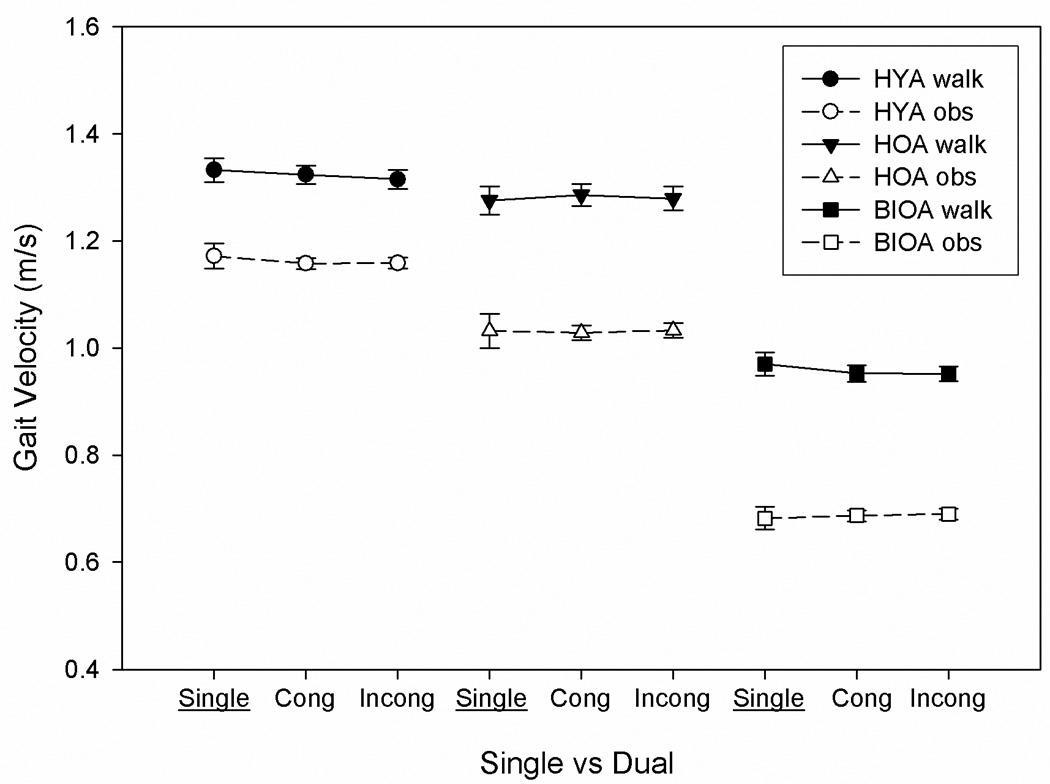

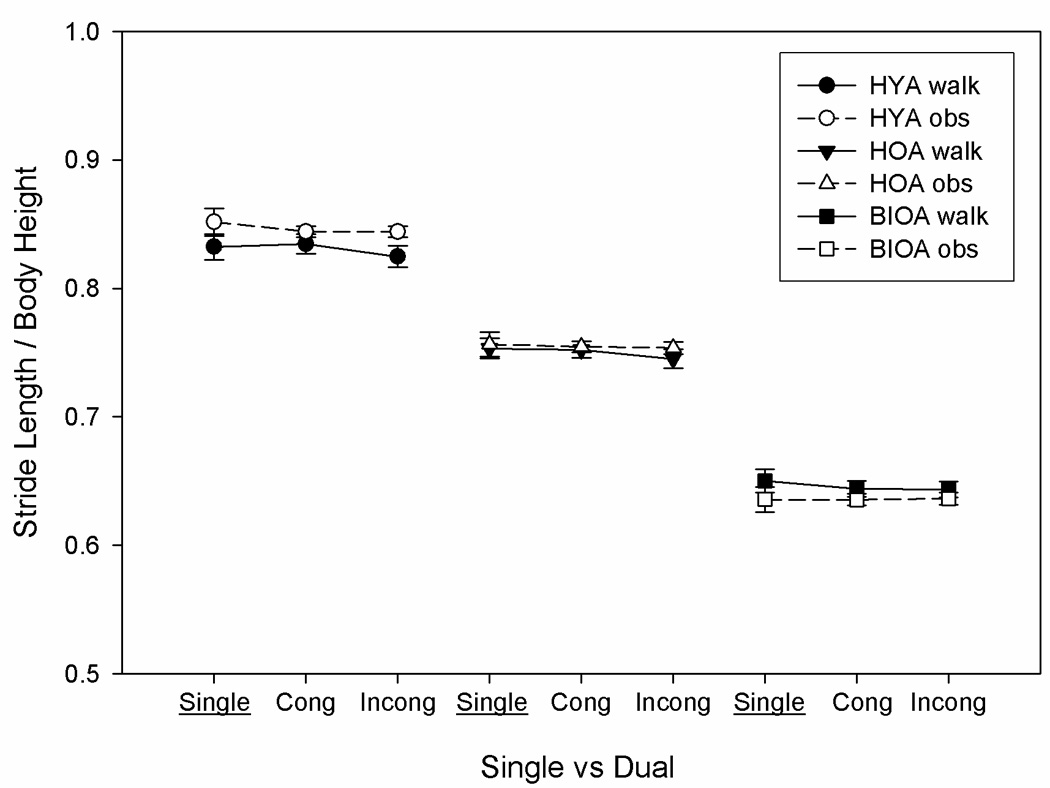
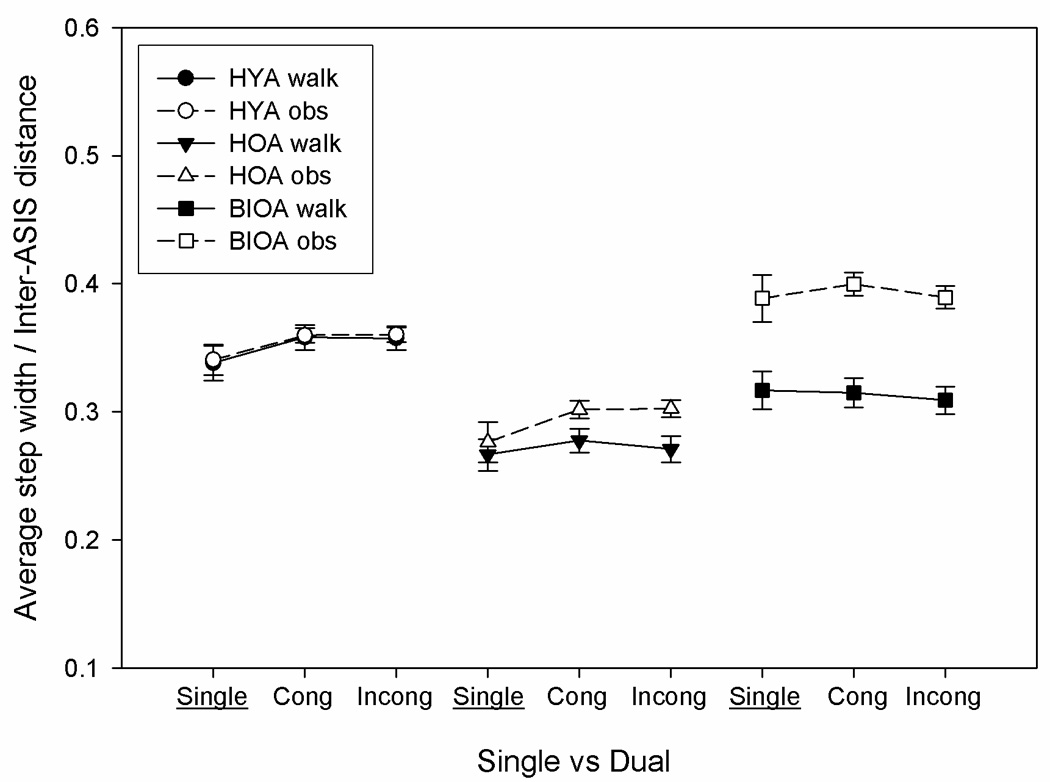
Gait temporal-distance measurements (mean ± standard errors) for the three groups during level walking and 10% obstacle avoidance in the single- and dual-task (congruent or incongruent) situations. Solid lines represent walking conditions (walk), whereas dotted lines represent obstacle avoidance conditions (obs).
However, significant interactions between groups and conditions were found (Gait velocity: F2, 33 = 145.88, p< 0.001; Stride time: F2, 33 = 244.34, p < 0.001; Stride length: F2, 33 = 20.25, p < 0.001 and Step width: F2, 33 = 42.30, p < 0.001). When HYA and HOA were compared across the two postural conditions (level walking and 10% obstacle crossing), no significant differences were detected for gait velocity and stride time. Gait velocity decreased significantly in BIOA for both postural conditions when compared to HOA (or HYA) (p < 0.05 for BIOA vs. HOA; p < 0.0001 for BIOA vs. HYA). In the obstacle avoidance task, a significant increase in stride time was found in BIOA when compared with healthy participants (Figure 3).
HYA and HOA increased their stride length when stepping over the obstacle (p < 0.0001 for HYA; p < 0.05 for HOA). No differences were found in BIOA. In contrast, BIOA and HOA significantly increased step width when performing the obstacle avoidance task (p < 0.0001 for BIOA; p < 0.05 for HOA). No differences were revealed in HYA (Figure 3).
Across all participants, significant main effects in three testing situations were found for gait velocity (F2, 70 = 5.58, p < 0.05), stride length (F2, 70 = 8.38, p < 0.001) and step width (F2, 70 = 6.58, p < 0.05). This indicates that participants tended to reduce gait velocity with longer strides and wider steps when performing two tasks simultaneously.
There was no significant interaction (Groups*testing situations) for the toe-obstacle clearance in the leading limb (Figure 4a). However, significant interactions between groups and testing situations were found in the trailing toe-obstacle clearance (F4, 66 = 2.86, p < 0.05) between single task and dual-task situations (Figure 4b). Follow-up pair-wise analysis revealed that only BIOA significantly increased toe-obstacle clearance in the trailing limb during dual-task situations (p < 0.05).
Figure 4.
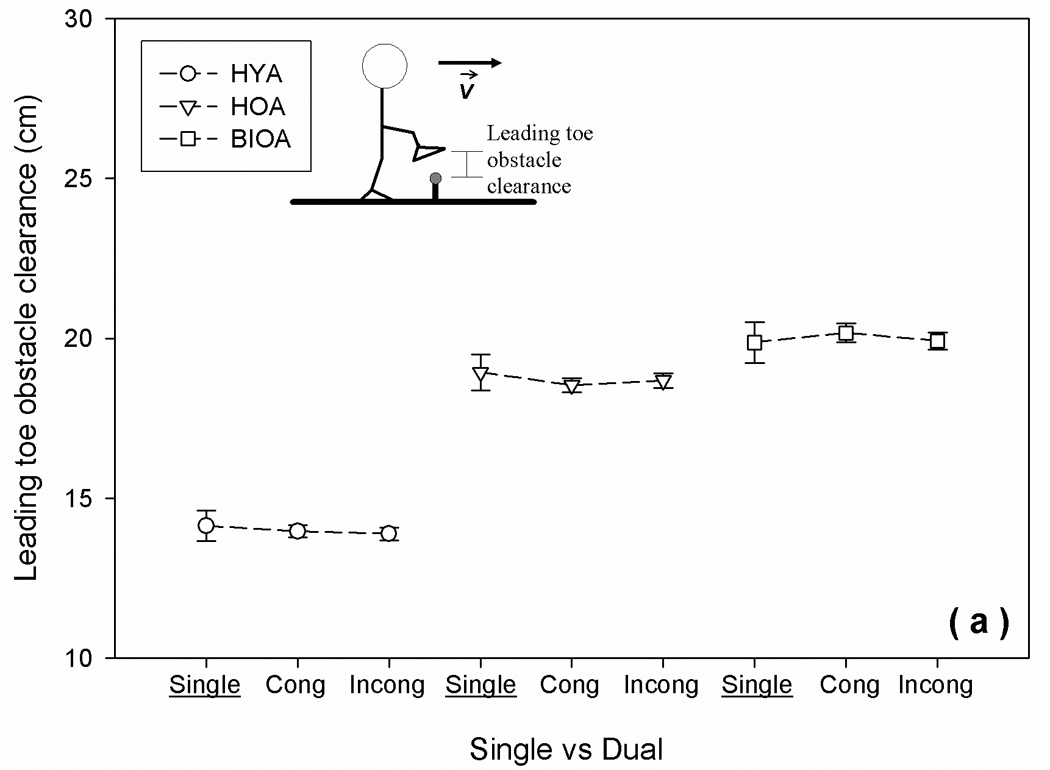
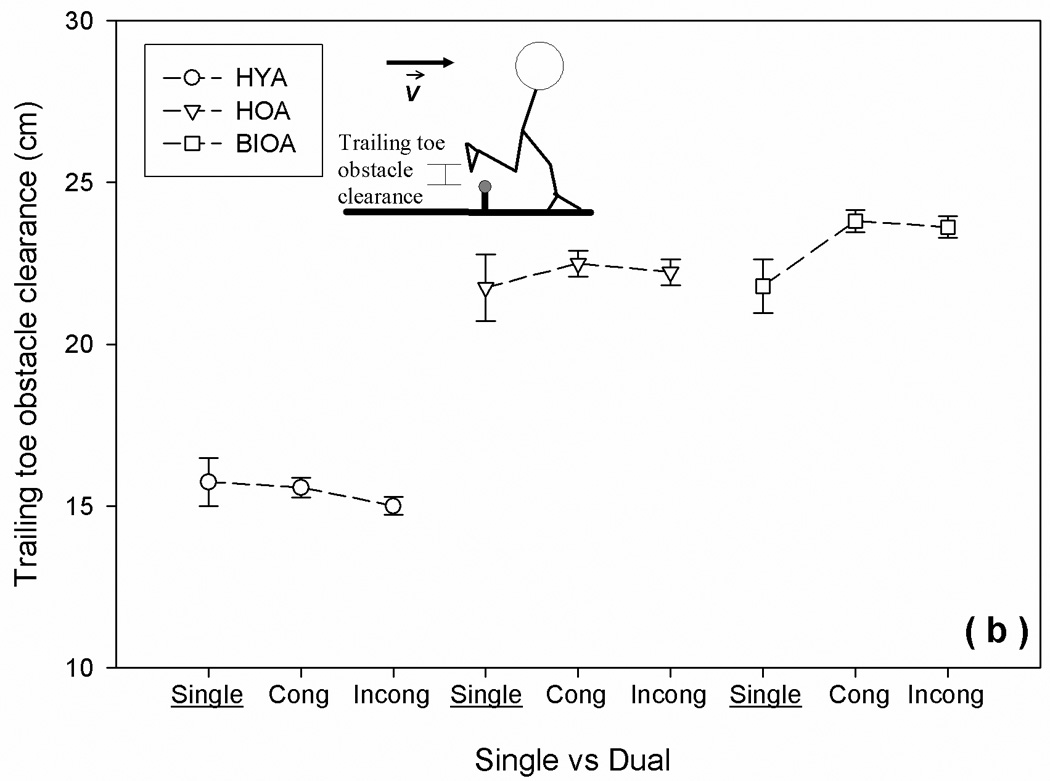
Toe-Obstacle clearances (mean ± standard errors) for the three groups in (a) the leading limb and (b) the trailing limb during 10% obstacle crossing in the single-and dual-task (congruent and incongruent) situations.
DISCUSSION
Previous studies have shown a reduction in the ability to maintain balance when simultaneously performing a postural task and a secondary cognitive task in BIOA compared to HOA. The dual-task deficits found in elderly fallers were not only in static balance control (1–2, 20), but also in dynamic gait control (11). In the current study, we extended the examination of dual-task interference in BIOA to a more challenging situation - stepping over an obstacle. A larger congruency effect in the Stroop task and more cautious gait performance were found in BIOA while performing two tasks simultaneously.
Auditory Stroop task performance
The VRT performance of the Stroop task was compared in three different postural conditions (seated, level walking and obstacle avoidance). An age effect was revealed during walking and obstacle avoidance indicating an increased VRT with more errors in HOA and BIOA compared to HYA. In addition, there were no differences between HOA and BIOA in VRT performance. It is possible that unobstructed walking and obstructed walking were both attentionally demanding in older adults with or without balance problems.
Comparing the two dual-task situations (congruent and incongruent conditions), it was demonstrated that the congruency effect was reduced as the difficulty of the postural tasks increased across all groups (Figure 2). Though obstacle avoidance is more challenging than level walking in older adults (17, 21), surprisingly, the difference between congruent and incongruent was diminished in the obstacle avoidance condition. This result was in line with a recent study (22) investigating the effect of working memory load on the Stroop task performance. These researchers found that the congruency effect was reduced when a concurrent working memory task overlapped with the distractor processing in the Stroop task. They suggested that when a common cognitive resource was shared by the working memory task and the Stroop task, attention would be diverted to the working memory task and result in a decreased congruency effect.
In the current study, diminished congruency effects may be due to participants prioritizing and diverting their attention to the obstacle avoidance task (13, 23), and focusing less on the Stroop task. It is important to note that BIOA showed the smallest “diminished congruency effect” among the three groups. This suggests that BIOA may not switch their attention efficiently between two tasks and as previous studies (1–2, 20) suggested, BIOA might suffer from an inability to allocate attention under dual-task situations.
Obstacle Avoidance task performance
During obstacle avoidance, BIOA showed significantly reduced gait velocity with an increase in stride time and step width (Figure 3). These data further confirmed that obstacle avoidance tasks could be a useful tool in the evaluation of older persons with balance impairment (24–25). As we hypothesized, the obstacle avoidance task was more attentionally demanding in BIOA.
Gait modifications such as increasing toe-obstacle distance were characterized in healthy older adults while performing two tasks concurrently (14). The current study extended the examination under dual-task situations to BIOA and found increased obstacle clearance, but no differences were found in HOA. An increase in obstacle clearance may represent one of the strategies used by the balance-impaired individual to gain a safer obstacle negotiation (26). Lamoureux and co-workers reported that vertical heel obstacle clearance was increased 8.4% in older adults after a 24-week progressive resistance-training program. They suggested that increased obstacle clearance was one of the improvements in functional gait and safe obstacle clearance strategies. Together, it is possible that findings of increased obstacle clearance in balance-impaired older adults represent a more conservative strategy for reducing the potential contact with the obstacle and minimizing the risk of falling.
Our data also revealed an interesting finding that the dual-task effects on toe-obstacle clearance were only found in the trailing limb, but not in the leading limb. This may be due to the fact that visual control of the lower limb is minimal when stepping over an obstacle with the trailing limb. Vision plays an important role in the control of locomotion (27) and obstacle negotiation (28). Visual input can provide information such as location of an obstacle or height of an obstacle to allow people to interpret the spatial information and prepare an appropriate action before reaching the obstacle. Increased obstacle clearance is a common action that people choose in order to avoid hitting an obstacle (27). However, during obstacle crossing with the trailing limb, visual information is not available; thus at that moment, obstacle avoidance becomes more challenging for BIOA. This may contribute to the increased toe-obstacle clearance that was shown in Figure 4b.
Dual-task interference in BIOA
When BIOA simultaneously performed the obstacle avoidance and Stroop task, they significantly increased their obstacle clearance. This evidence may suggest that BIOA attempted to prioritize their attention toward their gait performance. However, BIOA were distracted by performing the Stroop task concurrently, and showed a sustained and greater congruent effect in VRT than the other groups. It is possible that BIOA attempted to shift their attention back and forth between the obstacle avoidance task and the Stroop task. However, the ability to allocate attention between two tasks may be reduced in BIOA. This would create difficulties using this strategy when performing two tasks simultaneously. These findings provide further evidence to suggest that BIOA should perform one task at a time in daily activities requiring balance, and avoid multi-tasking in order to reduce the risk of falling.
CONCLUSION
Stepping over an obstacle is attentionally demanding in older adults, especially in BIOA. Verbal response time in the Stroop task and gait performance were modified in fallers while performing the two tasks. Our findings suggest that dual-task performance becomes more challenging in BIOA and may be caused by their inability to efficiently allocate attention between two tasks. Dual-task training under variable attentional priority instructions (29) is suggested as a useful rehabilitation protocol for the elderly to reduce the risks of falling when they perform more than one task in their daily activities.
ACKNOWLEGMENT
This study was support by the National Institute of Health, Aging Grant # AG-021598 (M. Woollacott, PI)
Contributor Information
Ka-Chun Siu, Motor Control Laboratory, Department of Human Physiology, Institute of Neuroscience, University of Oregon, Eugene OR, 97403, USA.
Vipul Lugade, Motion Analysis Laboratory, Department of Human Physiology, University of Oregon, Eugene OR, 97403, USA.
Li-Shan Chou, Motion Analysis Laboratory, Department of Human Physiology, University of Oregon, Eugene OR, 97403, USA.
Paul van Donkelaar, Motor Control Laboratory, Department of Human Physiology, Institute of Neuroscience, University of Oregon, Eugene OR, 97403, USA.
Marjorie H. Woollacott, Motor Control Laboratory, Department of Human Physiology, Institute of Neuroscience, University of Oregon, Eugene OR, 97403, USA.
REFERECES
- 1.Brauer S, Woollacott MH, Shumway-Cook A. The Influence of a Concurrent Cognitive Task on the Compensatory Stepping Response to a Stance Perturbation in Balance-Impaired Older Adults. Gait Posture. 2002;15:83–95. doi: 10.1016/s0966-6362(01)00163-1. [DOI] [PubMed] [Google Scholar]
- 2.Brauer S, Woollacott MH, Shumway-Cook A. The interacting effects of cognitive demand and recovery of postural stability in balance-impaired elderly. J Gerontol. 2001;56:489–496. doi: 10.1093/gerona/56.8.m489. [DOI] [PubMed] [Google Scholar]
- 3.Gabell A, Simons MA, Nayak USL. Falls in the healthy elderly: predisposing causes. Ergonomics. 1985;28:965–975. doi: 10.1080/00140138508963219. [DOI] [PubMed] [Google Scholar]
- 4.Nevitt MC, Cummings SR, Hudes ES. Risk factors for injurious falls: A perspective study. J Gerontol. 1991;46:164–170. doi: 10.1093/geronj/46.5.m164. [DOI] [PubMed] [Google Scholar]
- 5.Shumway-Cook A, Woollacott M. Attentional demands and postural control: the effect of sensory context. J Gerontol. 2000;55:10–16. doi: 10.1093/gerona/55.1.m10. [DOI] [PubMed] [Google Scholar]
- 6.Connell BR, Wolf SL Atlanta FICSIT Group. Environmental and behavioral circumstances associated with falls at home among healthy elderly individuals. Arch Phys Med Rehabil. 1997;78:179–186. doi: 10.1016/s0003-9993(97)90261-6. [DOI] [PubMed] [Google Scholar]
- 7.Verghese J, Buschke H, Viola L, et al. Validity of divided attention tasks in predicting falls in older individuals: a preliminary study. J Am Geriatr Soc. 2002;50:1572–1576. doi: 10.1046/j.1532-5415.2002.50415.x. [DOI] [PubMed] [Google Scholar]
- 8.LaJoie Y, Teasdale N, Bard C, Fleury M. Attentional demands for static and dynamic equilibrium. Exp Brain Res. 1993;97:139–144. doi: 10.1007/BF00228824. [DOI] [PubMed] [Google Scholar]
- 9.Lindenberger U, Marsiske M, Baltes P. Memorizing while walking: increase in dual task costs from young adulthood to old age. Psychol Aging. 2000;15:417–436. doi: 10.1037//0882-7974.15.3.417. [DOI] [PubMed] [Google Scholar]
- 10.Lundin-Olsson L, Nyberg L, Gustafson Y. Stops walking when talking as a predictor of falls in elderly people. Lancet. 1997;349:617. doi: 10.1016/S0140-6736(97)24009-2. [DOI] [PubMed] [Google Scholar]
- 11.Beauchet O, Dubost V, Gonthier R, Kressig RW. Dual-task-related gait changes in transitionally frail older adults: the type of the walking-associated cognitive task matters. Gerontology. 2005;51:48–52. doi: 10.1159/000081435. [DOI] [PubMed] [Google Scholar]
- 12.Chen HC, Aston-Miller JA, Alexander NB, Schultz AB. Effects of age and available response time on ability to step over an obstacle. J Gerontol. 1994;49:227–233. doi: 10.1093/geronj/49.5.m227. [DOI] [PubMed] [Google Scholar]
- 13.Chen HC, Schultz AB, Ashton-Miller JA, Giordani B, Alexander NB, Guire KE. Stepping over obstacles: Dividing attention impairs performance of old more than young adults. J Gerontol. 1996;51:116–122. doi: 10.1093/gerona/51a.3.m116. [DOI] [PubMed] [Google Scholar]
- 14.Schrodt LA, Mercer VS, Giuliani CA, Hartman M. Characteristics of stepping over an obstacle in community dwelling older adults under dual-task conditions. Gait Posture. 2004;19:279–287. doi: 10.1016/S0966-6362(03)00067-5. [DOI] [PubMed] [Google Scholar]
- 15.Overstall PA, Exton-Smith AN, Imms FJ, Johnson AL. Falls in the elderly related to postural imbalance. Br Med J. 1977;1:261–264. doi: 10.1136/bmj.1.6056.261. [DOI] [PMC free article] [PubMed] [Google Scholar]
- 16.Berg KO, Wood-Dauphinee SL, Williams TJ, et al. Measuring balance in the elderly: validation of an instrument. Can J Public Health. 1992;83:S7–S11. [PubMed] [Google Scholar]
- 17.Hahn ME, Chou L-S. Age-related reduction in sagittal plane center of mass motion during obstacle crossing. J Biomech. 2004;37:837–844. doi: 10.1016/j.jbiomech.2003.11.010. [DOI] [PubMed] [Google Scholar]
- 18.Winter DA. Biomechanics and Motor Control of Human Movement. 2nd Ed. New York: Wiley-Interscience; 1990. [Google Scholar]
- 19.Woltring HJ. A FORTRAN package for generalized, cross-validatory spline smoothing and differentiation. Advances in Engineering Software. 1986;8:104–113. [Google Scholar]
- 20.Shumway-Cook A, Woollacott M, Kerns KA, et al. The effects of two types of cognitive tasks on postural stability in older adults with and without a history of falls. J Gerontol. 1997;52:232–240. doi: 10.1093/gerona/52a.4.m232. [DOI] [PubMed] [Google Scholar]
- 21.Chou LS, Kaufman KR, Hahn ME, Brey RH. Medio-lateral motion of the center of mass during obstacle crossing distinguishes elderly individuals with imbalance. Gait Posture. 2003;18:125–133. doi: 10.1016/s0966-6362(02)00067-x. [DOI] [PubMed] [Google Scholar]
- 22.Kim SY, Kim MS, Chun MM. Concurrent working memory load can reduce distraction. PNAS. 2005;102:16524–16529. doi: 10.1073/pnas.0505454102. [DOI] [PMC free article] [PubMed] [Google Scholar]
- 23.Brown LA, McKenzie NC, Doan JB. Age-dependent differences in the attentional demands of obstacle negotiation. J Gerontol Med Sci. 2005;60A:924–927. doi: 10.1093/gerona/60.7.924. [DOI] [PubMed] [Google Scholar]
- 24.Means KM. The obstacle course: a tool for the assessment of functional balance and mobility in the elderly. J Rehabil Res Dev. 1996;33:413–428. [PubMed] [Google Scholar]
- 25.Rubenstein LZ, Josephson KR, Trueblood PR, Yeung K, Harker JO, Robbins AS. The reliability and validity of an obstacle course as a measure of gait and balance in older adults. Aging (Milano) 1997;9:127–135. doi: 10.1007/BF03340138. [DOI] [PubMed] [Google Scholar]
- 26.Lamoureux E, Sparrow WA, Murphy A, Newton RU. The effects of improved strength on obstacle negotiation in community-living older adults. Gait Posture. 2003;17:273–283. doi: 10.1016/s0966-6362(02)00101-7. [DOI] [PubMed] [Google Scholar]
- 27.Patla AE. Understanding the roles of vision in the control of human locomotion. Gait Posture. 1997;5:54–69. [Google Scholar]
- 28.Patla AE, Rietdyk S. Visual control of limb trajectory over obstacles during locomotion: effect of obstacle height and width. Gait Posture. 1993;1:45–60. [Google Scholar]
- 29.Silsupadol P, Siu KC, Shumway-Cook A, Woollacott MH. Training of balance under single- and dual-task conditions in older adults with balance impairment. Phys Ther. 2006;86(2):269–281. [PubMed] [Google Scholar]


